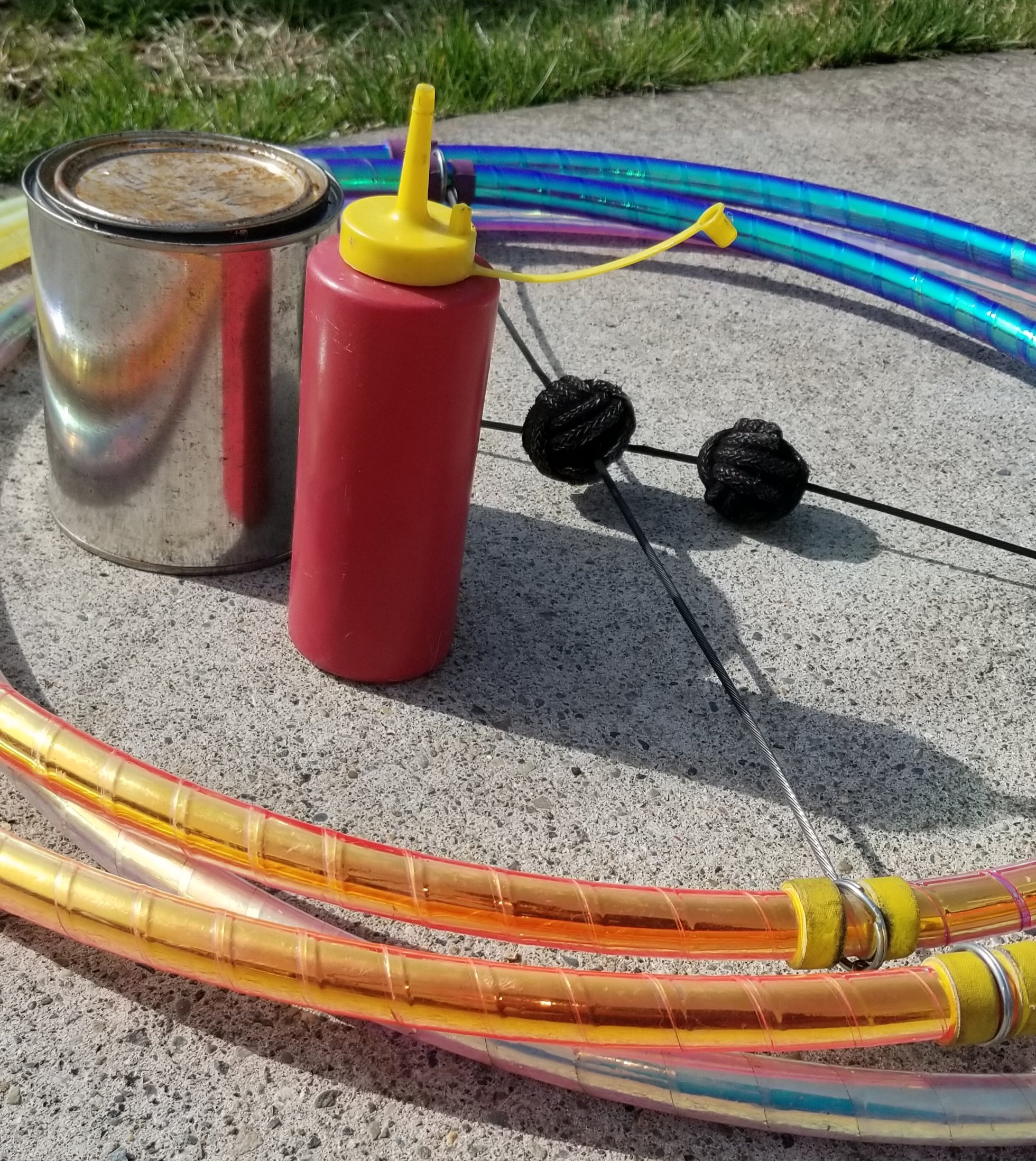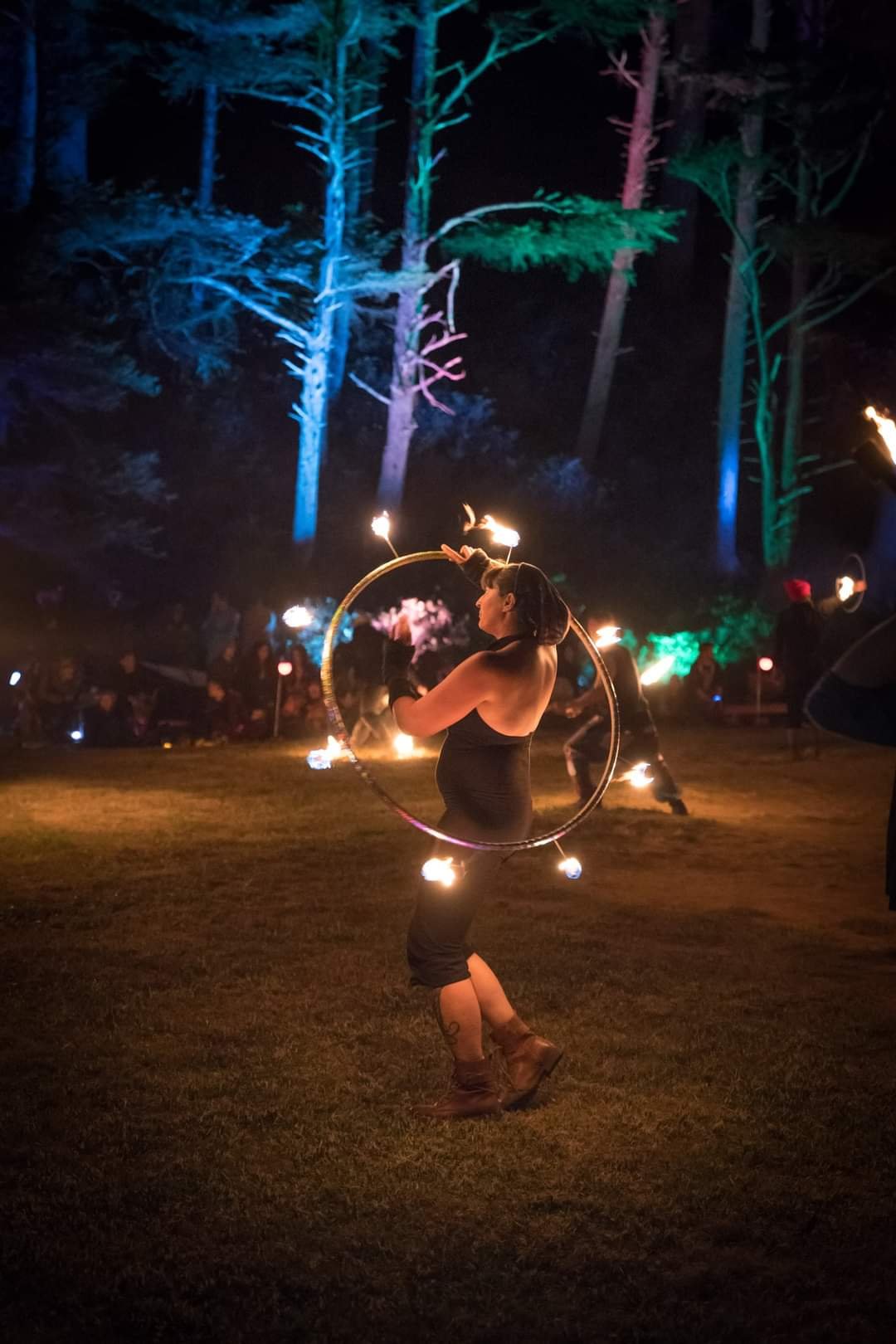If you are feeling the fire spinning bug and are ready to start to prepare for your first venture into getting yourself outfitted, but you don’t know where to begin, this guide should help! This is part 1 in this series and should be followed by our next guide as well. Want to watch it on YouTube? Find it here
To make things convenient, you can print this list and take it shopping with you, check things off as you go, and add your own items.
Livi’s personal collection of gear
Daytime is a great time to get your gear gathered and looked over for loose wicks, check your fuel levels and make sure you have everything before you are ready to practice your fire hoop session.
Our picks for fuel brands!
Camp Fuel is the number one type of fuel used in the fire spinning community and may be considered the only type of fuel that you need for most applications. Also known as white gas or naptha it can be mixed with Lamp oil or paraffin to bring the temperature down on the flames—which is great for close-range fire spinning. It also extends the burn time slightly. A flame that burns 50/50 mixed fuel has an amber color (as opposed to a brighter white flame of straight white gas), and it also emits more soot. Lamp oil has the tendency to wear down wicking faster. Personally it’s my favorite to spin with and I think the trade-off on the lower temp is worth the soot. Just a quick note to add: Lamp oil is not the same as kerosene. It is cleaner and more refined than kerosene. Avoid using Citronella lamp oil.
Consider proper storage for your fuel! If possible, it should be kept away from living areas, and it should be kept out of spots that get very hot. Ensure that the lids are correctly sealed.
Dip Cans to store your fuel
You will need some sort of container to pour fuel into so that you can dip your props. These can also safely tote and store unused fuel. Both types have their pros and cons and functionality can depend on your props. It’s important that whatever you use has a secure lid. Plastic containers should be avoided, metal is ideal.
Ammunition cans
Ammunition containers can be found at some hardware stores or sporting goods or Surplus Army stores. They are also being made in plastic but I would avoid those. These can be useful for dipping larger props. They have a locking lid with a rubber gasket seal (check it often for wear) and a handle for carrying.
Empty Paint Cans are a nice way to store your fuel and dip your hoop wicks!
Paint cans are a favorite type of dip can for fueling. They are available in Quart (shown) or Gallon sized. I personally like a small one for dipping my wicks, since the larger ones need to be filled deeper in order for the wicks to reach the fuel line. I also keep two of them so I have one for white gas and one for my 50/50 blend. The small paint can is also nice for these Portal style fire hoops, where you will acually bring the can up to a wick that is positioned downward for dipping, or you can use the pour-over method. Be sure to close lids or cover once you are done fueling your prop.
If you have Iso Style wicks you might be wondering how to dip them!
If you have Fire Iso Hoops or Gyro hoops and you’re wondering how to dip this style of wick, the method is a little different. Basically you are doing the “Pour-Over” method. with these. We like to use a condiment squeeze bottle to suction fuel out of the dip can and over the top of the wick. Once you collect the fuel in the bottle, hold the hoop so the wick is placed over the dip can. Pouring the fuel directly on the ground is not only wasteful, but it’s just not that environmentally-friendly. You only need to suction out enough fuel to saturate the wick… which is really only about a Tablespoon or so. If you don’t have a squeeze bottle, you can use a turkey baster if you have one. Last resort can be a direct pour-over method, using a fuel-safe and clean cup or jar to pour the fuel over the wick and into the dip can. Finally, you will lightly tap the wick over the dip can, as this is going to be your “Spin-off” for your hoop. Don’t need to go crazy here, just until the drips are done.
Safety first! Did I mention to invite a friend to keep an eye on you?
Fire Blanket for Safety! You will need some sort of fire proof cloth for smothering flames. Fire blankets are used by your safety person for emergency situations that involve wrapping around an area on an individual who has caught themselves on fire. They are also used in general for extinguishing props. This is one of our Duvetyne Fire Blankets and it’s a common type of safety blanket in the fire community. There are also Aramid fiber fire blankets available on the market. For some fire spinners, a wet bath towel is sufficient in a pinch. Duvetyne blankets are affordable and available in 12 oz for most small fire props, or fire hoops; or 16 oz Commando cloth for larger props such as swords and dragon staffs and fans. Care: This cloth is actually treated with a fire retardant, and may need to be replaced if it gets drenched or washed. You can also re-treat it if you happen to have fire retardant spray. It’s not intended to be washed, and it should be stored in dry places, kept in ziplock bags once it’s aired out from any dewy evenings,.
Tools are handy!
Don’t forget to bring your wicks AND tools for installing them! If you have the Removeable style of wicks that screw-in, a pair of basic pliers are helpful for tightening your stems after they have been hand-tightened. Or if you have the Clamp-on style quick wicks you will find it helpful to have a nut driver hand tool, or a flathead screwdriver. In a pinch you can use a coin, a nail file, debit card, a piece of bark…but these methods are not as easy to use especially in the dark or cold! These tools can usually be found pretty cheap at Harbor Freight tools or your local hardware store.
Arm Sleeves for heat protection
Fire sleeves for added safetly and protection. This fingerless style covers the base of the hand all the way up to the elbow and can be nice as a heat protection layer against the hot metal of the hoop wicks and the flame itself. Made with fire proof material, our Sleeves are an affordable option. There are certainly other handmade options available on the market as well. Some are made out of a cotton blend or even Nomex material and are often available in nice colors and or screen printed or slit-weaved. Just don’t lose your fancy sleeves!
Other essentials that you might find useful
Extra sandwich zip bags for covering your fueled hoop wicks and spinning off in a more environmentally-friendly way. They can also be used during performances when you might need to Pre-fuel your props, to keep the fuel from evaporating from your wicks.
Oil lamp for lighting your props from. This is just a nice alternative to having someone light you up with a lighter. You still need a lighter though to light your lamp. If you are traveling be sure to use a container with a lid for your lamp. I have a metal tin with a lid (not shown) for my oil lamp. These require lamp oil. Sterno cans or candles are also used by some individuals, just don’t get the wax or fuel gel on your props!
Baby Socks for covering your wicks if you don’t have Wick Covers. Lots of decorative wick covers can be found online as well, and can range from bright and furry, to flowy silk flag types. I tend to prefer baby socks because they are cheap and I don’t stress about losing them. These days I have been pretty lazy about putting the socks on my fire hoops and the roof of my car now has tons of soot marks.
A lighter—don’t forget your lighter!
A large zip bag to contain things such as bandaids and burn cream (lavender oil or mustard packets also work to help soothe baby burns), wipes, headlamps, a paint can opener (not shown here), or keys, wallet, phone, etc.
It might also be helpful to have a small lantern to have near your fuel station.
Fire Spinning Kit on the go!
Five Gallon buckets are really helpful for toting your kit. They have handles for carrying, and can also help safely contain fuel buckets during your fire session, adding an additional barrier from any props that may accidentally get tossed nearby. While you should be keeping your fuel station a minimum of 25 feet away from your flow area, adding an extra element of safety is never a bad idea. Buckets tend to be more stable while traveling in vehicles, and this particular brand is available in a bright color that is easy to see at night, and has a “Caution cone” feel to it. If you are inclined you can also fill it with water for a safety measure, or carry a second bucket specifically for that purpose.
Livi is wearing fire-friendly Harmonic Threads to safely spin.
Photo Credit: Stu HoneyBadger
Fire Friendly clothing! Have fun dressing up for your fire spinning outfit, but please put your safety first! Garments should never be full synthetic. Natural fibers are your best friend. Cotton, Hemp, Bamboo, Linen (but not loose linen garments) are going to be types of fabric you want to wear. If it’s a blend of polyester or spandex, make sure that it’s still mostly natural (95% Cotton/5% Spandex, for example).
Fit should be tight or Close-fitting to your body. Think of any areas of fabric that is away from your body as potential fire “Pockets”. Strings or strips of fabric hanging should be thought of as “wicks” themselves. If you do have dangles, make sure they are minimal at best and definitely natural fiber.
There are some companies out there that specifically make fire friendly clothing for performers and spinners. My personal favorite clothing line is Harmonic Threads but you can probably find lots of slow-fashion type clothing on Etsy as well!














